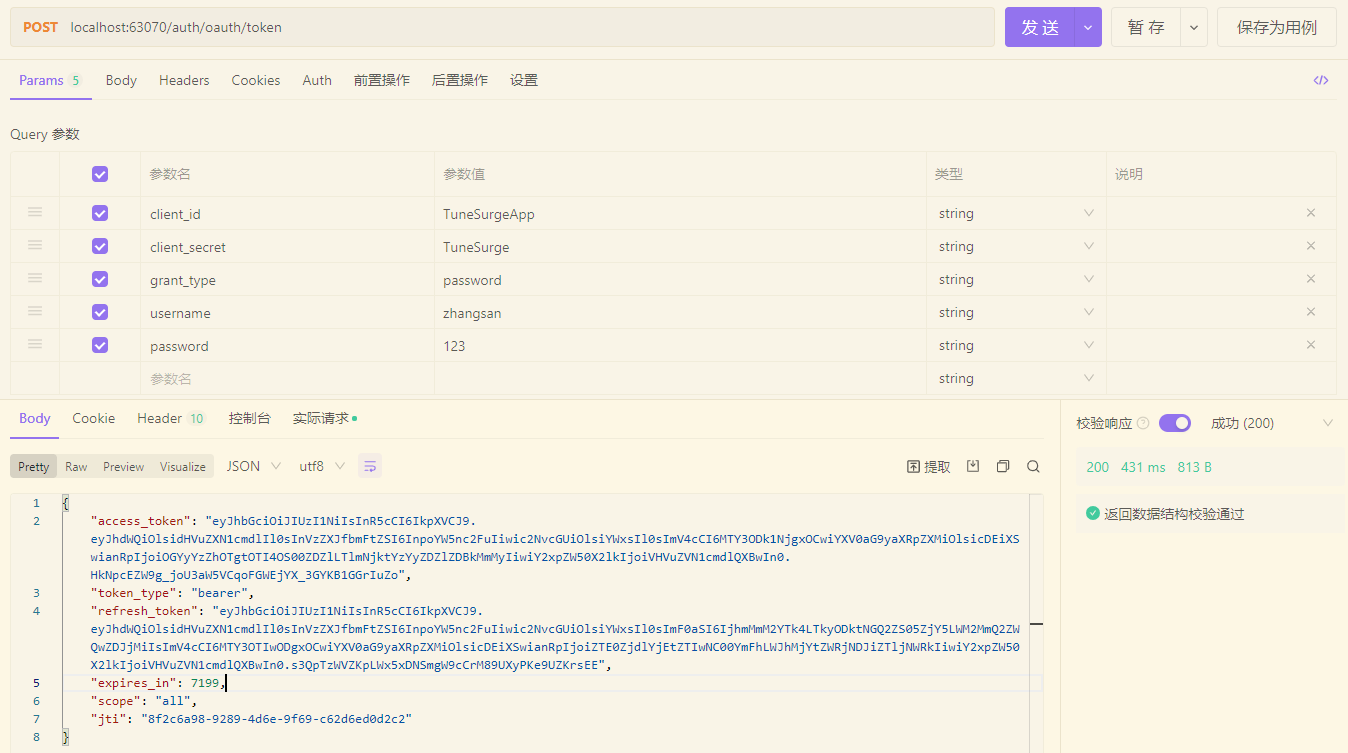前言
使用Spring Security OAuth2时,源码对于返回消息没有做一个统一的封装。为了统一规范,我们可以采取一些措施。
下图是原初访问**/oauth/token**获取token时,成功和失败(源码抛出异常时的响应示例)


基于AOP的切点表示式
观察控制台日志:
1
| 2023-03-16 14:55:08.940 WARN 25476 --- [io-63070-exec-5] o.s.s.o.p.e.TokenEndpoint : Handling error: InvalidGrantException, 用户名或密码错误
|
可以得到程序是在TokenEndpoint类中接受了处理,并返回了结果
阅读源码发现
postAccessToken和handleException方法处理了信息的返回
那么思路很暴力很简单,切点表达式,直接对这两个方法做AOP处理
1
2
3
4
5
6
7
8
9
10
11
12
13
14
15
16
17
18
19
20
21
22
23
24
25
26
27
28
29
30
31
32
33
34
35
36
37
38
39
40
41
42
43
| @Component
@Aspect
public class AuthTokenAspect {
@Around("execution(* org.springframework.security.oauth2.provider.endpoint.TokenEndpoint.postAccessToken(..))")
public Object handleControllerMethod(ProceedingJoinPoint pjp) throws Throwable {
RestResponse<Object> response = new RestResponse<>();
Object proceed = pjp.proceed();
if (proceed != null) {
ResponseEntity<OAuth2AccessToken> responseEntity = (ResponseEntity<OAuth2AccessToken>) proceed;
OAuth2AccessToken body = responseEntity.getBody();
if (responseEntity.getStatusCode().is2xxSuccessful()) {
response.setCode(0);
Map<String, Object> map = new HashMap<>();
assert body != null;
map.put("access_token", body.getValue());
map.put("token_type", body.getTokenType());
map.put("refresh_token", body.getRefreshToken().getValue());
map.put("expires_in", body.getExpiresIn());
map.put("scope", body.getScope());
map.put("jti", body.getAdditionalInformation().get("jti"));
response.setData(map);
response.setMsg("登录成功");
} else {
response.setCode(-1);
response.setMsg("登录失败");
}
}
return ResponseEntity
.status(200)
.body(response);
}
@Around("execution(* org.springframework.security.oauth2.provider.endpoint.TokenEndpoint.handleException(..))")
public Object handleException(ProceedingJoinPoint pjp) throws Throwable {
Object proceed = pjp.proceed();
ResponseEntity<OAuth2Exception> response = (ResponseEntity<OAuth2Exception>) proceed;
return ResponseEntity
.status(200)
.body(RestResponse.validFail(Objects.requireNonNull(response.getBody()).getMessage()));
}
}
|
其中,RestResponse是我自己封装的同意返回体
得到返回结果:


基于全局MVC增强
本到这里就结束了,可笔者认为此方法不过完美,在网上得到了重写/oauth/token等MVC端点,再使用@ControllerAdvice增强来实现,十分优雅。故做此纪录:
1
2
3
4
5
6
7
8
9
10
11
12
13
14
15
16
17
18
19
20
21
22
23
| @RestController
@RequestMapping("/oauth")
public class AuthorityController {
@Resource
private TokenEndpoint tokenEndpoint;
@RequestMapping(value = "/token", method = RequestMethod.POST)
public RestResponse<Oauth2TokenDto> postAccessToken(Principal principal, @RequestParam Map<String, String> parameters) throws HttpRequestMethodNotSupportedException {
OAuth2AccessToken oAuth2AccessToken = tokenEndpoint.postAccessToken(principal, parameters).getBody();
Oauth2TokenDto oauth2TokenDto = Oauth2TokenDto.builder()
.accessToken(oAuth2AccessToken.getValue())
.refreshToken(oAuth2AccessToken.getRefreshToken().getValue())
.expiresIn(oAuth2AccessToken.getExpiresIn())
.tokenHead("Bearer ")
.scope(oAuth2AccessToken.getScope())
.jti(oAuth2AccessToken.getAdditionalInformation().get("jti").toString()).build();
return RestResponse.success(oauth2TokenDto);
}
}
|
这里新建一个Controller类重写了postAccessToken的处理逻辑,并新建了OAuth2AccessToken类返回结果信息
1
2
3
4
5
6
7
8
9
10
11
12
13
14
15
16
17
18
19
20
21
22
23
24
25
26
27
28
29
30
31
32
33
| @Data
@Builder
public class Oauth2TokenDto {
private String accessToken;
private String refreshToken;
private String tokenHead;
private int expiresIn;
private Set<String> scope;
private String jti;
}
|
对于异常信息,我直接定义一个全局异常来处理:
1
2
3
4
5
6
7
8
9
10
11
12
13
| @Slf4j
@ControllerAdvice
public class GlobalExceptionHandler {
@ResponseBody
@ExceptionHandler(Exception.class)
@ResponseStatus(HttpStatus.INTERNAL_SERVER_ERROR)
public RestResponse<String> doException(Exception e) {
log.error("捕获异常:{}", e.getMessage());
return RestResponse.validFail(e.getMessage());
}
}
|


总结
为了”统一规范“,这里造成了不少的牺牲,让代码侵入性变的很强,我认为不如和前端约定好,关于OAuth2的模块的返回结果进行针对性的处理。






